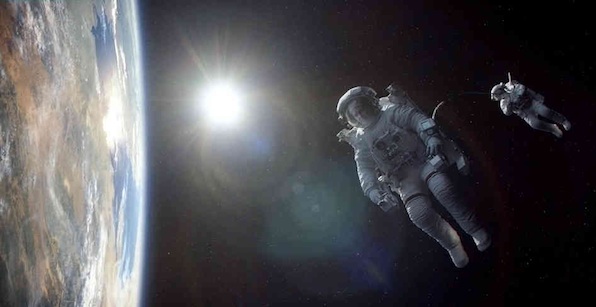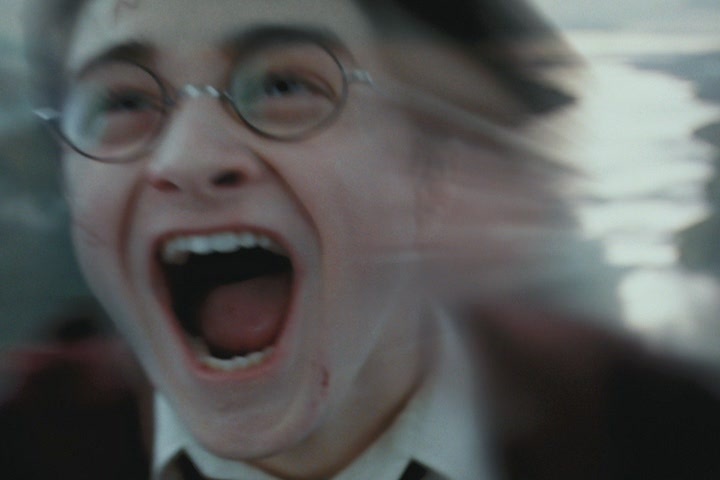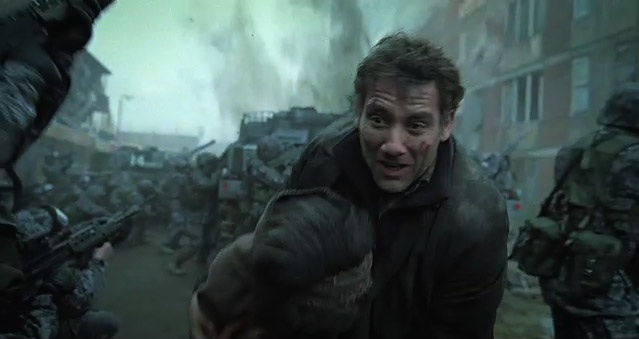Charged with describing the first twenty minutes of Alfonso Cuarón’s Gravity to friends, you may find it difficult to convey to them the awe of the fact that nothing much happens in a conventional plot sense, and that what doesn’t happen is precisely the source of this opening’s, and by extension the remainder of the film’s, exhilaration. While there’s a little dialogue that obviously makes expository points for later use, there’s none of the feverish hustle and bustle that we’ve grown to expect from contemporary American mainstream movies, which are often too anxious to distinguish themselves from the remaining unceasing stimuli of pop culture as manifested on TV and online, as well as on Facebook, Twitter, Instagram and the hundreds of phone apps that were probably invented as I typed this. The opening functions as an announcement of at least two prevailing sorts: of Cuarón’s flabbergasting mastery of a gimmick that’s beginning to fade on cue (don’t worry 3D fans, it will return to you in twenty years if precedent can be trusted), and of the film’s all-enveloping sense of quiet in this age of relentless multi-tasking preoccupation with whatever lies ahead of us rather than directly in front of us.
Gravity is one of those rare great pop films that can speak to several groups of people at once in slightly different ways. Cinephiles will be conscious of the impressive formalism, particularly the long, long takes that can be said, without fear of courting hyperbole, to take the audience as close to the terrifying sensation of floating around seemingly willy-nilly in space as a contemporary film is presently capable of taking us. More casual filmgoers might not directly seize on Cuarón’s use of unbroken shots (though some have and will), but they will subconsciously respond to the film’s freedom of movement. Simply, Gravity restores a sense of awe to the pop film. Less simply, it revels in an existence that’s untethered by our everyday hang-ups. People were said a few years ago to have come down with the “Avatar blues,” and I imagine that Gravity has inspired similar despairingly hungover returns to reality once the initial exhilaration of watching it has subsided.
This sensual freedom that Cuarón achieves—this illusion of casual, unfussy grace—wasn’t arrived at overnight; like any other permutation of artistic mastery, it has been developed, honed, and painstakingly pursued. There are otherwise perceptive, intelligent writers who seem to believe that Cuarón is a particularly ambitious journeyman filmmaker and little more, as he moves efficiently from subject to subject and genre and genre, and this short-sightedness ignores the obsessions that clearly govern all of his films, which all concern the yearning for freedom, a potentially banal theme, except that Cuarón has evolved into one of our prominent poets of freedom.
It took Cuarón, for instance, to seize upon a subtext in J.K. Rowling’s Harry Potter novels that seemed to have entirely eluded Chris Columbus, the director of the first two films: That Harry’s discovery of a magical world represented for him, in the classic tradition of heroes in fantasy literature, an astonishing chance to flourish above the everyday drudgery that he accepted as his eternal prison. (Harry’s essentially a typical middle-class person writ large with Dickensian flourishes.) It’s clear early on that Cuarón’s Harry Potter and the Prisoner of Azkaban is up to something different and more interesting than the prior Columbus adaptations, as there’s a newfound hyper-awareness of texture and nuance to the series that’s reminiscent of Cuarón’s adaptations of A Little Princess and Great Expectations as well as original projects like Sólo con tu pareja and Y tu mamá también. The special effects aren’t presented to the audience with the dull sense of over-produced, eager-to-please processional pageantry that characterized the Columbus films. Cuarón is alive to the little things, such as a shrunken head that hangs over the rearview mirror of a magic bus, or the various little creatures that are rendered with a sense of specificity and awe that was previously unknown to this series.
But there’s one scene in Harry Potter and the Prisoner of Azkaban that really asserts itself as a self-contained poem of movement, one that allows us to fully savor Harry’s exhilaration as he begins to come into himself as a person apart from the impoverished stair-dweller his loathsome aunt and uncle are determined to assume him to be. Harry’s friend and brief teacher Hagrid introduces Harry and his classmates to a creature called a Hippogriff, which resembles a winged horse that’s been blessed with the poignantly vain head of a bird. Hagrid tells Harry that it’s a proud creature, and to regard it respectfully, a notion with which the continually abused and disrespected Harry can immediately empathize. Harry understands the yearning for space, for life, and the creature, sensing this and responding to it, takes Harry high into the air, dashing in and around the castles of the school ground before descending to a plane that’s right above a body of water’s surface, which the creature, in a breathtaking moment of appreciation, briefly breaks with his claw in a gesture of communal rapture. This scene’s only flaw is its brevity, and so you retrospectively wonder if Cuarón was considering that limitation as he pushed the boundaries of tracking shots years later in Children of Men and, particularly, Gravity.
In this context, it’s logical, then, that Cuarón would become as occupied with tracking shots as he has in his recent films, as they reflect a unity of various artistries that must co-exist and flourish for the length of an entire movement without any reality-shattering missteps. A long tracking shot represents a brief surge of transcendence above the rigors of the dozens of set-ups that might be normally required of a scene shot with a traditional degree of “coverage”; the kind of transcendence that his characters are always searching for. Sólo con tu pareja, A Little Princess, Great Expectations, and Y tu mamá también are deeply sensual films, but the eroticism of their preoccupation with release from environmental constraint isn’t expressed with long mobile takes, but through longer stationary takes that allow you to pause from the official obligations of the story to regard the characters’ emotional turmoil from afar. (One scene in Y tu mamá también particularly illustrates this approach: When Julio retreats from a hotel room after accidentally catching Tenoch and Luisa having sex for the first time. Julio’s subsequent moment of wounded contemplation captures the distinctly exclusionary dimension of others’ sexual coupling in a way I’ve never seen in any other movie.)
Perhaps it’s that aforementioned “afar” that inspired Cuarón to push and evolve the formal grammar of his films. At the time, Children of Men struck me as a stylish and well-orchestrated disappointment that signaled its detachment from the emotional contours of its characters with the very tracking shots that were so widely applauded. In this film, you sense Cuarón working for his technical brilliance, as the camera’s choreography appears to be diagrammed within an inch of its livelihood, squandering creative energy that might have been spent in the service of the kind of play, humor, and pathos that usually characterize a Cuarón production. Children of Men represented the potentially dispiriting transformation of a sensualist into a mannered Kubrickean formalist, and we have plenty of the latter, precious few of the former.
Gravity also offers a third announcement, then, that’s aimed straight at the Cuarón-philes in the audience: the merging of the director’s sensuality with a newly confident flowing formalism that Children of Men’s failure paved the way for, and which often literally appears to take you straight into the characters’ minds and thought processes. The film is less Kubrickean than Ophülsian, as in the great director Max Ophüls, who made films that often appeared to obliterate the conventional lines between the characters and the audience with breathless tracking shots that brought you straight into the characters’ respective worlds. The great achievement of Gravity is ultimately democratic: Cuarón allows you to share the freedom he feels as an artist, as his sense of collusion with his characters ultimately extends as a sense of collusion with his audience, with you.







